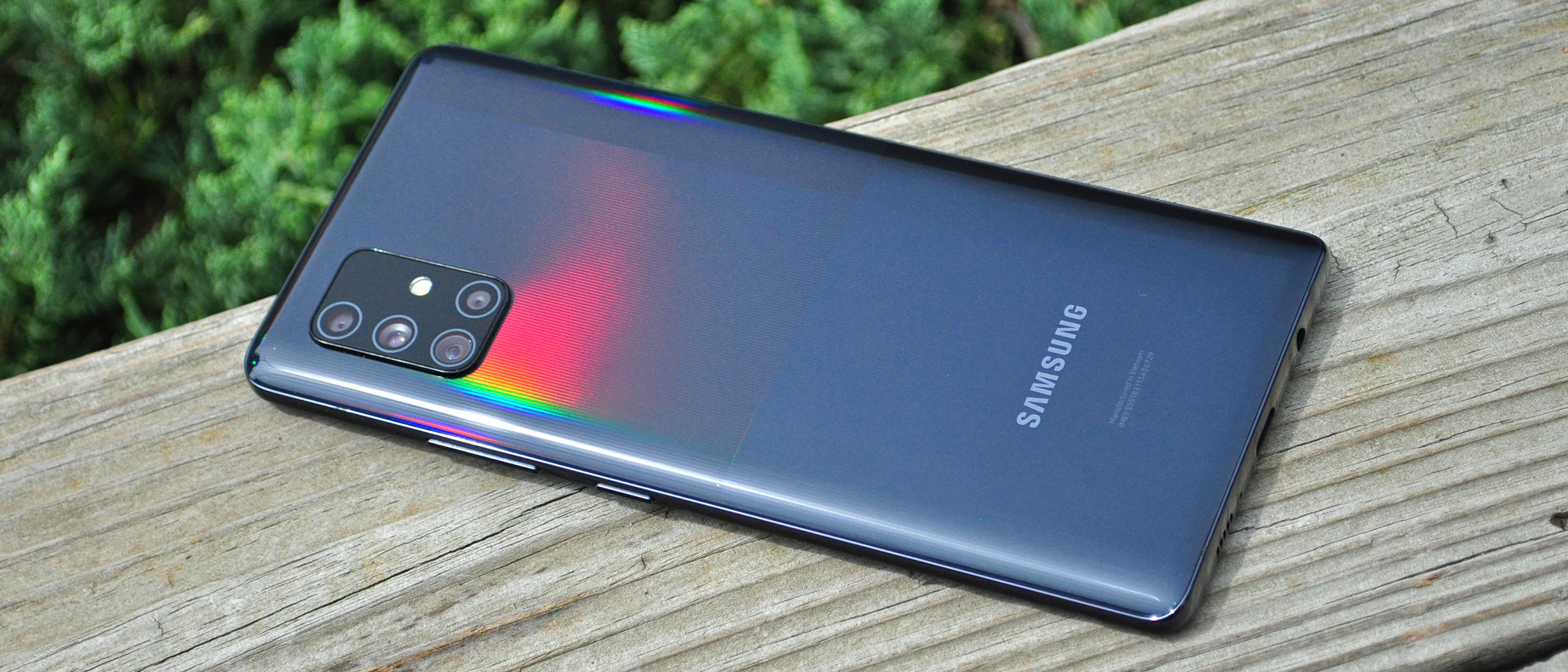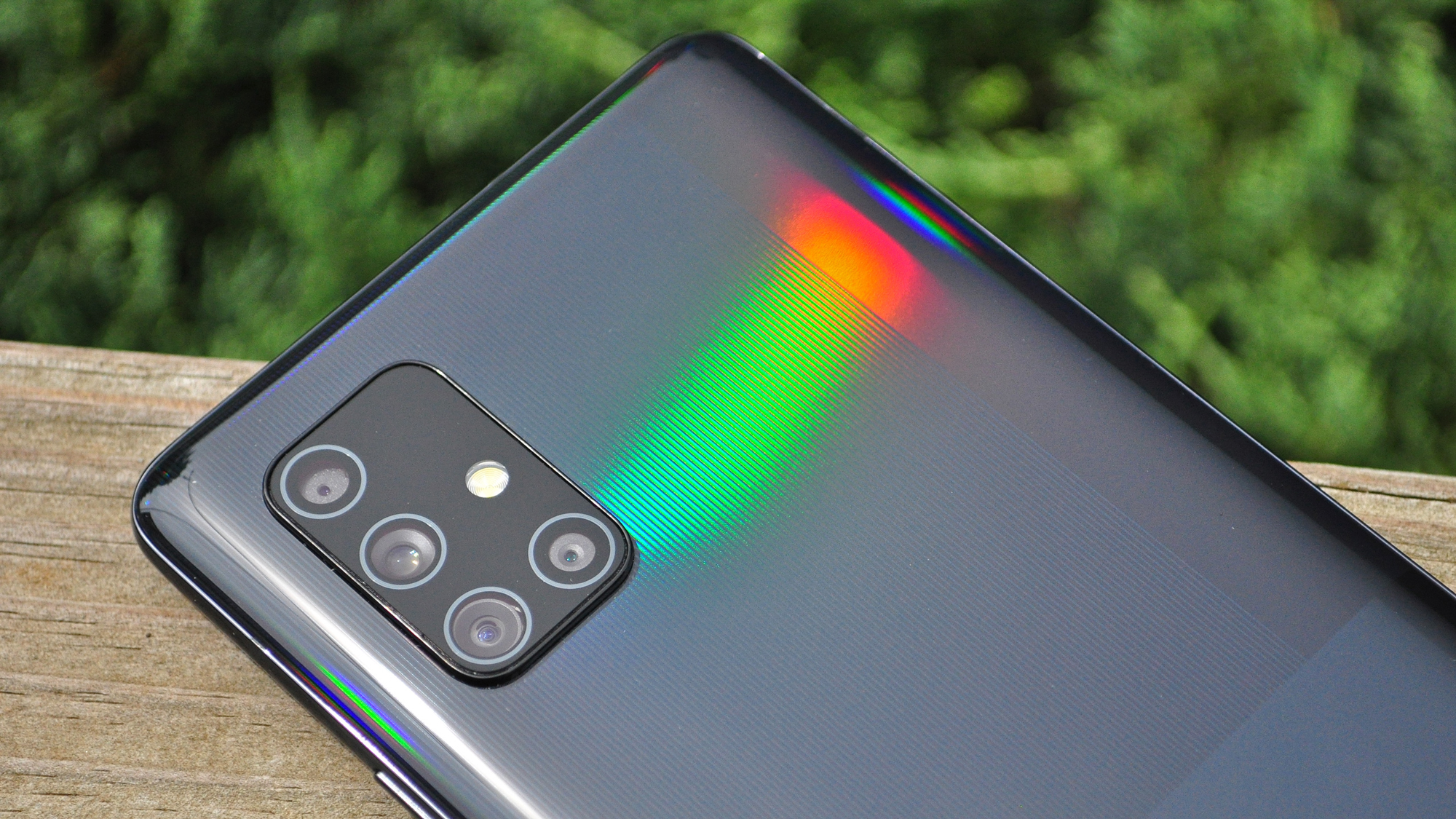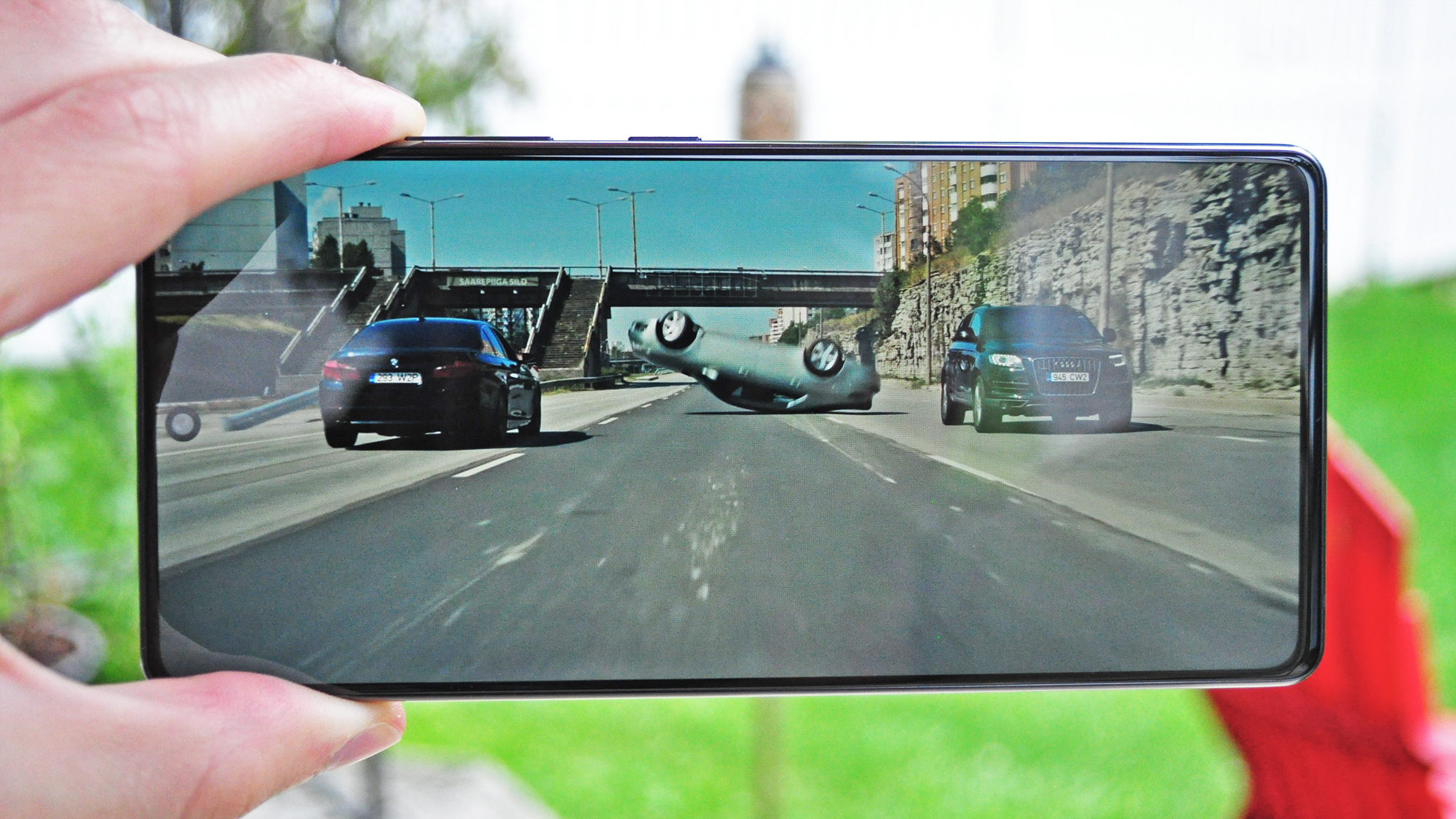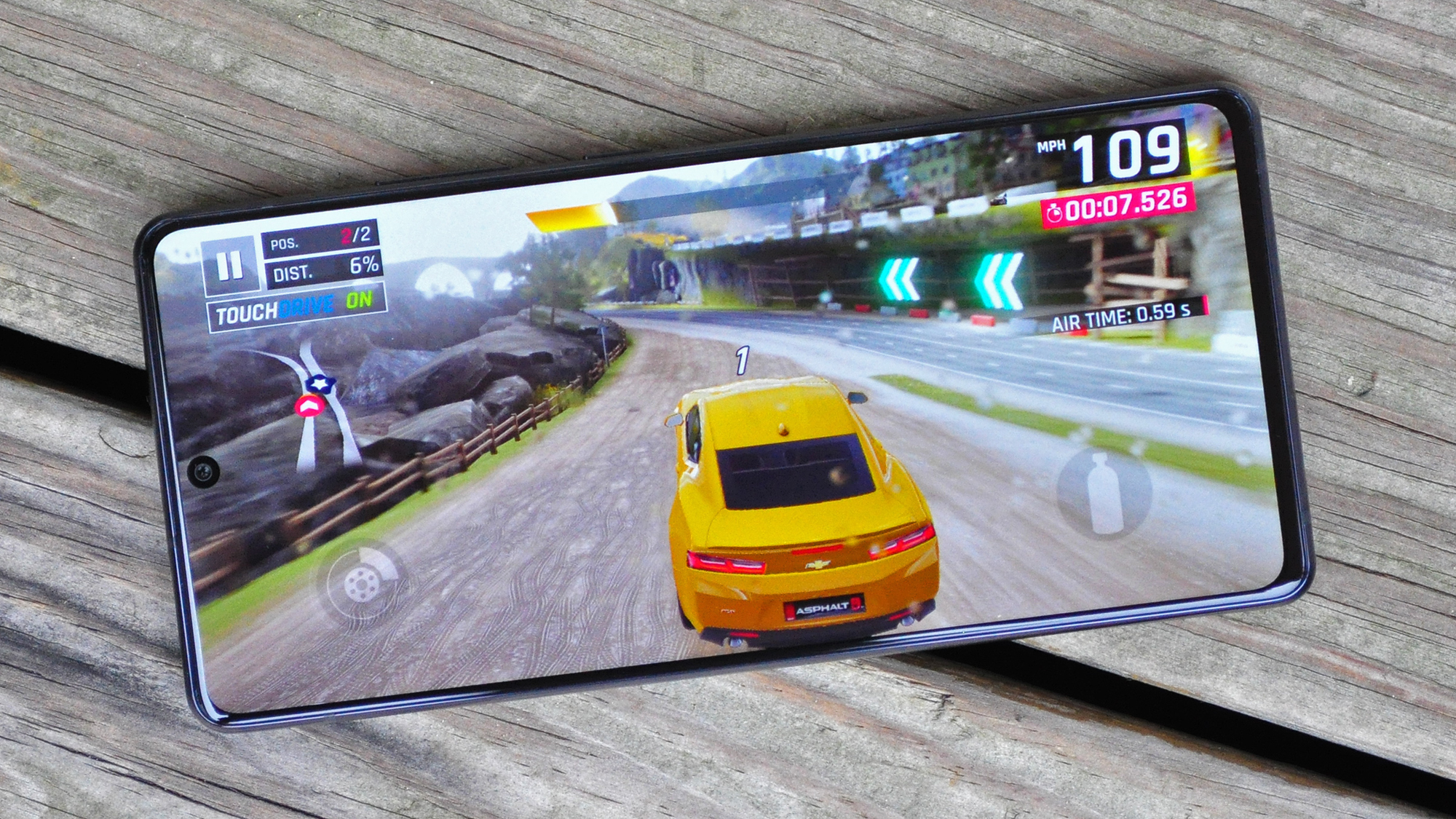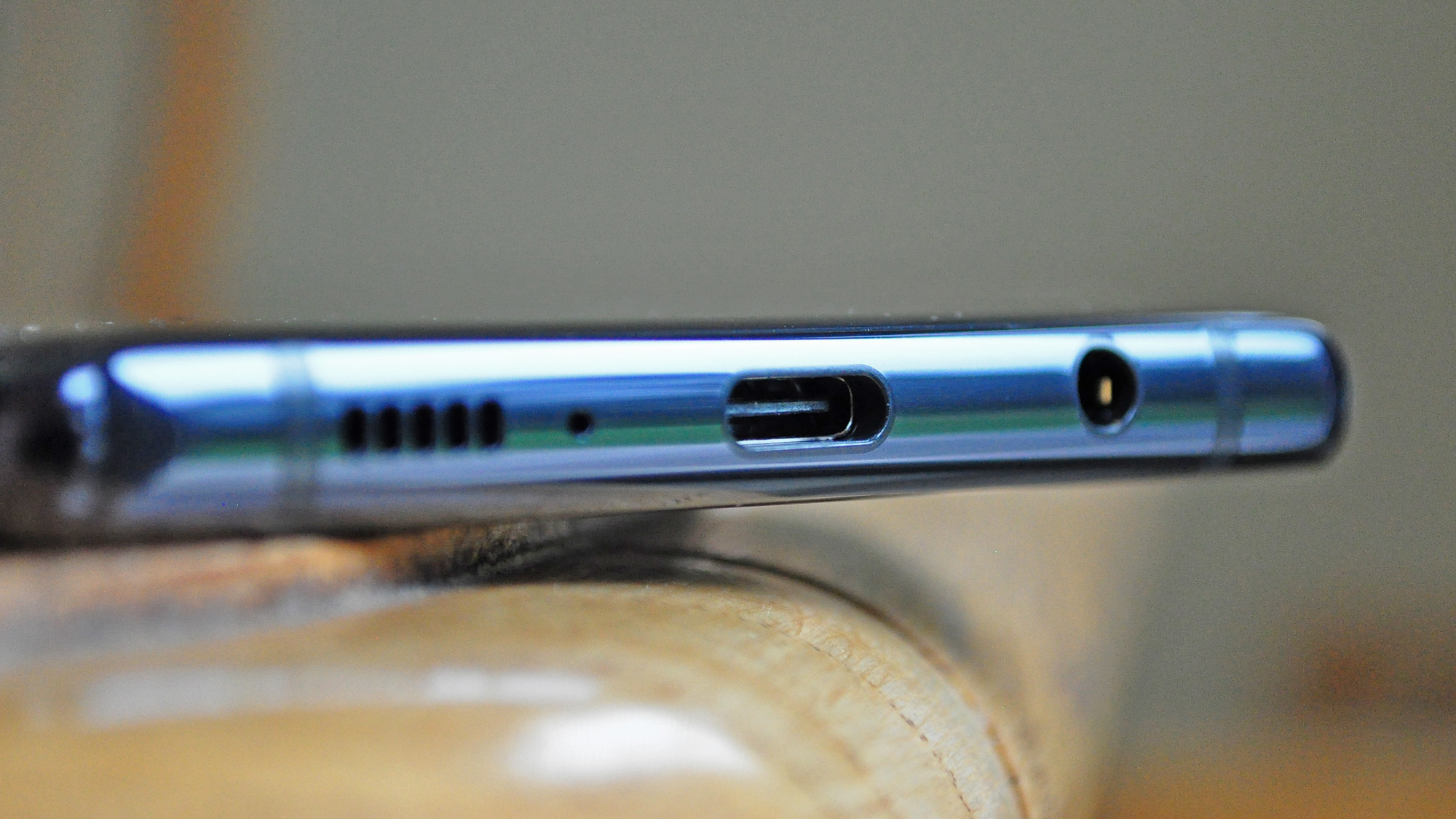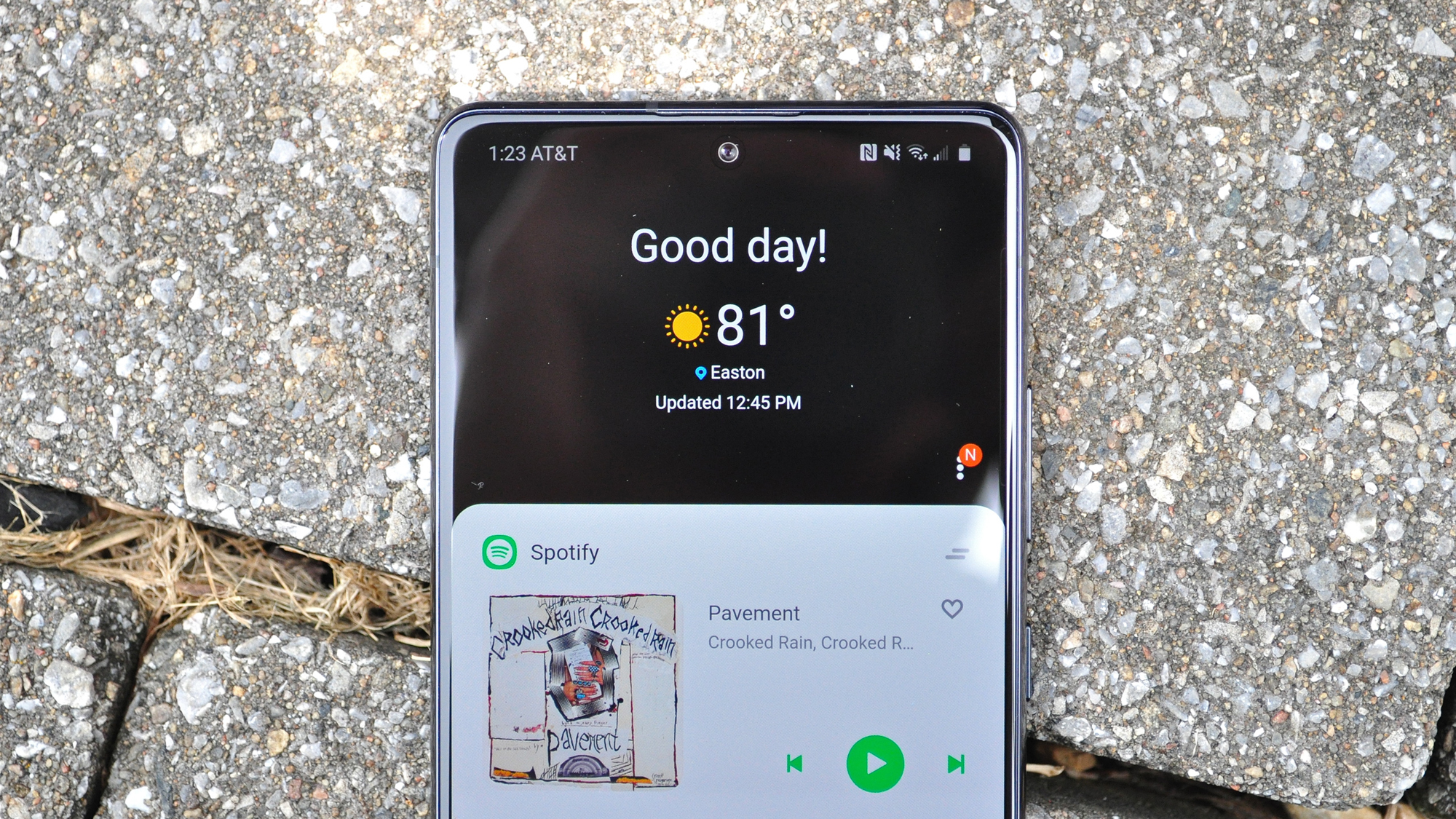Tom's Guide Verdict
The Samsung Galaxy A71 offers a cheaper path to 5G service if that’s important to you, but otherwise it’s only a decent $600 phone. For hundreds less, the Pixel 4a and iPhone SE are better in almost every respect, save for battery life, while the OnePlus Nord is a much more well-rounded sub-$500 5G option for those who can buy it.
Pros
- +
Good battery life
- +
Solid performance
- +
5G support
- +
Big OLED display
Cons
- -
Tons of bloatware
- -
Cameras are just decent
- -
No wireless charging
- -
Frustrating fingerprints sensor
- -
A bit pricey for what it is
Why you can trust Tom's Guide
Price: $599 (unlocked and most carriers), $649 (Verizon)
OS: Android 10 with One UI 2.0
Display: 6.7-inch OLED (2400x1080)
CPU: Snapdragon 765
RAM: 8GB
Storage: 128GB
Rear camera: 64MP main (ƒ/1.8), 12MP ultrawide (ƒ/2.2), 5MP macro (ƒ/2.4), 5MP depth (ƒ/2.2)
Front camera: 32MP (ƒ/2.2)
Battery: 4,500 mAh
Battery life: 10:49
Size: 6.40 x 2.97 x 0.32 inches
Weight: 6.53 ounces
Samsung’s cheap phones used to be so dull, you wouldn’t wish one on your worst enemy. Fortunately, the company has stepped up its game in the last year, and the Samsung Galaxy A71 5G is proof of that. For $599, the A71 sits above the rest as the top dog of Samsung’s A-series lineup for 2020, and just as the name suggests, it can even connect to 5G networks.
Between its massive 6.7-inch AMOLED display, 4,500-mAh battery that lasted nearly 11 hours in our battery test and respectable overall performance, there’s much to like here, as you’ll find in our Samsung Galaxy A71 5G review. Unfortunately for Samsung, the race for the best unlocked phone has never been tighter than it is now, with the Pixel 4a, iPhone SE and OnePlus Nord locked in contention for top honors. All three of those handsets are also considerably cheaper than the A71 — relegating Samsung’s latest midrange contender to also-ran status, rather than a first-tier choice.
- The best Android phones right now
- Samsung Galaxy Note 20 Ultra review — the best Android phone ever
Samsung Galaxy A71 5G review: Pricing and availability
The Samsung Galaxy A71 5G costs $599 — so long as you buy it unlocked or through AT&T, T-Mobile or US Cellular. Verizon offers the A71 as well, though it’s a version called the Galaxy A71 5G UW that’s been customized to connect to Big Red’s millimeter wave-based 5G network. That Verizon variant tacks on a $50 premium, bringing the price up to $649.
No matter where you buy your Galaxy A71, you’ll get 128GB of built-in storage alongside 8GB of RAM. Storage is expandable with the use of a microSD card. All A71 devices are powered by Qualcomm’s Snapdragon 765 processor.
A word on the Galaxy A71’s 5G support. Excusing the Verizon-specific UW version, the A71 5G connects to sub-6GHz 5G networks. These towers offer service that is faster than existing 4G LTE, though not by a profound margin. AT&T and T-Mobile now classify their 5G networks as “nationwide,” though coverage is still quite spotty. Using our AT&T model, I wasn’t able to pick up 5G in a Pennsylvanian suburb. Your mileage may vary.
Samsung Galaxy A71 5G review: Design
Don’t let its relatively modest price fool you — the Galaxy A71 5G is a big phone, owing to its 6.7-inch display. Minimal bezels encircling the panel help keep the footprint trimmed as much as possible, but can’t save the fact that the A71 is actually harder to use one-handed than the taller-yet-more-slender Galaxy S20 Plus.
Fortunately, the A71 is made a little less cumbersome by its curved back, which once again utilizes the same “glastic” material as on the Galaxy A51. Samsung has treated this plastic in such a way that it does feel more solid and substantial than plastic on midrange phones typically is, but our Prism Black unit still has a semi-reflective iridescent pattern on it that looks a little chintzy. The A71’s not ugly or not overwhelmingly cheap-feeling — but it’s still quite a ways away from the glass and metal of flagships.
Get instant access to breaking news, the hottest reviews, great deals and helpful tips.
The front-facing camera on the Galaxy A71 5G is housed in a center-mounted hole punch with a slender earpiece just above it. However, as I soon found out listening to Spotify on the A71, this earpiece does not double as one of the phone’s stereo speakers. The lone speaker is on the bottom edge, next to the USB-C port, meaning it can be very easily covered by your palm especially when gaming. I prefer to hold big phones by cradling the bottom with my pinky, and so I naturally obscured that bottom-firing speaker every time I picked the A71 up. It was a bit annoying, to say the least.
The A71 does not support wireless charging, which is a bit surprising given that this phone only costs $100 less than the iPhone 11, which can charge wirelessly. Also unlike the iPhone 11 or Samsung’s recent Galaxy S-series models, the A71 is not rated water resistant at any level. Neither feature is unreasonable to expect from a device costing more than $500; nevertheless, they’re both absent on the A71. At least Samsung didn’t nix the headphone jack.
Like many other phones these days, the A71 bakes its fingerprint sensor into the display. And although that might seem like a luxury for midrange buyers, this scanner can be so stubborn to use that it had me longing for the days of rear-mounted capacitive sensors on Android devices. There’s certainly a learning curve to figuring out how the placement at which the A71 best reads your fingerprints, though even after I thought I’d figured that out, I still found myself reapplying through trial and error on some occasions.
Samsung Galaxy A71 5G review: Display
The Galaxy A71 features one of Samsung’s Super AMOLED panels, with a full-HD resolution spanning 6.7 inches. Because of the relatively low pixel count for the size, jagged edges of text, icons and graphics are a bit more readily apparent than on big phones with quad-HD panels, though that’s somewhat forgivable for this price.
The A71 also lacks a fast-refresh panel, like you get on the 90Hz OnePlus Nord or 120Hz Galaxy S20. This isn’t a massive nor surprising loss, again considering the price, though high refresh rates are appearing in cheaper and cheaper phones, and OnePlus has broken the $500 barrier with the new Nord. The A71’s screen feels pretty run-of-the-mill by comparison.
That said, this isn’t a poor display by any means. It gets reasonably bright, topping out at 481 nits under our light meter. It also delivers strong hues, particularly if you opt for its Vivid color profile. The trailer for the upcoming Christopher Nolan film, Tenet, showcased the A71’s impressive dynamic range as I watched flashes of sunlight glint off waves crashing up against a coastal Mediterranean town.
Indeed, the A71’s panel can display a vast range of colors, as it rendered 200.3% of the sRGB color space in our testing. If you find that too saturated, you can always step down to the Natural color profile for a bit less pop. Meanwhile, the A71’s Delta-E color accuracy score of 0.33 is a bit behind the Pixel 4a (0.29) and further back from the iPhone SE (0.20). (Numbers closer to zero are more accurate.)
Samsung Galaxy A71 5G review: Camera
On the back of the Galaxy A71 are four cameras: a 64-megapixel wide-angle lens, 12MP ultra wide, 5MP macro and 5MP depth sensor. Three of those, apart from the 64MP primary camera, are the same as what you’ll find in the Galaxy A51 I tested back in May; the only notable upgrade here is that main lens, which uses pixel binning to produce optimized 16-MP images.
Overall, the A71’s photography is serviceable, if not stunning. Comparing it to our top cheap camera phone, the new Pixel 4a, the A71 certainly delivers a brighter shot here though I wouldn’t necessarily say it looks better. There’s some detail missing in the white fringes of the flower’s petals. The Pixel’s camera picks up these specular highlights, which conveys a sense of texture and depth. Samsung’s chronic insistence on banishing shadows and contrast doesn’t help in that regard, either.
A similar comparison using a different flower, this time against the iPhone SE, yielded similar results. Apple’s imaging tech churns out astonishing detail here, thanks to processes like Deep Fusion, which leverages the power of the iPhone SE’s A13 Bionic chip to combine many exposures into one before picking out the sharpest aspects of each. The A71 can’t convey the petals’ texture with the same stunning granularity even as it plays up the highlights, and the natural bokeh of the background is less consistent and exquisite as well.
You could argue that the A71’s primary appeal to photographers, then, will be the plethora of perspectives it offers, rather than the individual quality of any of its four lenses. That’s a position I’d agree with, as neither the iPhone SE nor the Pixel 4a features secondary ultra wide and macro lenses designed for shooting expansive landscapes or hyper close-ups. Granted, I’m not sure anyone really needs a macro camera — the A71’s does indeed let you capture images from mere inches away, though the quality isn’t anything that would cause me to beg for one in my next smartphone.
Additionally, the computational photography on display in Samsung’s midrange devices still can’t compare with what’s offered in Google’s more affordable alternative. The A71’s Night Mode clearly loses here to the Pixel 4a’s Night Sight, which was able to capture an image that was simultaneously less noisy and more visible than anything Samsung’s device could muster. The Pixel can also paint more definition and color in the highlights on the house’s siding and through the window, contributing to a more balanced shot overall.
Even though the A71 features a 32-MP front-facing camera, the selfies it takes don’t necessarily seem any sharper to me than what the iPhone SE delivers. As it turns out, that’s because the Galaxy uses pixel binning through the front lens as well, though I can’t say that’s done anything for this Portrait Mode selfie of yours truly. My skin tone is totally washed out through Samsung’ shooter, even though both pictures you see here were taken outside on a sunny afternoon. Additionally, I’m floored by the detail the iPhone SE lends to my shirt — intricacies of the fabric that the A71 glosses over. At least Samsung’s device fared slightly better with the bokeh, especially around my hair.
Samsung Galaxy A71 5G review: Performance
Inside the Galaxy A71 5G is Qualcomm's Snapdragon 765 processor, which is also appearing in other moderately-priced 5G phones these days. (The new OnePlus Nord uses a similar 765G chip better optimized for gaming.)
In the A71, the Snapdragon 765 is tied to 8GB of RAM, delivering great overall performance — even if its showing in benchmarks is markedly short of Qualcomm's faster 8-series silicon.
Whether browsing the web, working on Google Docs or generally thumbing around Android, the A71 handles basic tasks with ease and gives away nothing in performance to more high-end phones. It's only when you play a game that the Snapdragon 765's limits are tested.
Arcade racer Asphalt 9 ran smoothly enough at its default medium graphics option, though frame rates decreased steeply when I ratcheted the experience up to a more demanding setting, and the back of the device started to heat up as well. You can dabble in serious gaming with the A71, but avid players ought to look elsewhere for the best gaming phone.
Overall, though, the A71’s performance is sufficient. When I reviewed the $399 Galaxy A51, I came away amazed how often that phone could be so easily flummoxed by routine situations, like unlocking and launching apps. The A71 isn't plagued by those hiccups at all, and I'd much more confidently recommend it for that reason.
The A71 holds its own in benchmarks, scoring 1,796 points in the multi-core portion of the system-wide Geekbench 5 test. That’s a bit faster than the Pixel 4a, which topped out at 1,647, though unsurprisingly far off the mark compared to 865-powered phones like the OnePlus 8, which reached 3,387 points — never mind the 3,226 score of the A13 Bionic-powered iPhone SE.
In terms of graphics performance, the A71 was less than half as quick as the OnePlus 8, recording 551 frames at 8.6 frames per second in GFX Bench’s Aztec Ruins Vulkan test for high-tier devices. The OnePlus 8 recorded 1,322 frames at 21 fps.
Samsung Galaxy A71 5G review: Battery life and charging
The 4,500-mAh battery inside the Galaxy A71 lasted an average of 10 hours and 49 minutes in Tom’s Guide’s custom battery test, where the device endlessly loaded web pages over a mobile connection while set to 150 nits of screen brightness until running out of juice.
That’s a shade behind the OnePlus 8 (11:04) and iPhone 11 (11:20), but still good for a sub-$600 phone and ahead of the average smartphone. The Pixel 4a and iPhone SE, two sub-$400 phones we love, managed just 8:55 and 9:18, respectively.
Not only does the Galaxy A71 last longer on a charge than the Pixel 4a and iPhone SE — it charges faster, too, with an included 25-watt adapter that reaches 60% in just 30 minutes. Fast charging can be rare to find on cheaper handsets (and even more expensive ones, as the iPhone 11 only comes with a slow 5-watt brick), so it’s nice to see Samsung include the best available charging tech for the A71 in the box.
Samsung Galaxy A71 5G review: Software and special features
Samsung’s One UI 2.0 front end is based upon Android 10, and appears in the Galaxy A71 pretty much unchanged from how it looks and feels in the company’s pricier Galaxy S and Note models.
One UI adds some useful features, like the ability to take scrolling screenshots and create secure, password-protected folders, though it can also be a bit overwrought. The sleep/wake key, for example, which you’d typically expect to power off the device when held down, simply brings up Bixby by default. You can change this in the settings, though it’s a maddening trend of Samsung phones that continues in the A71.
There was also a glut of pre-installed apps on our AT&T unit. I counted 25, spanning everything from AT&T services to Amazon, Pluto TV, HBO Max, Final Fantasy XV and Monopoly. To make matters worse, much of this software appears in the daily briefing page to the left of the home screen, leading to a never-ending scrolling list of updates from apps like Giphy and PopSugar that read more like tabloid clickbait than genuinely useful news and information. There’s simply too much going on, and you get the sense it’s all been done to serve Samsung and its partners first, and the user second.
Again, many of these apps and design decisions that make One UI somewhat cumbersome to navigate can be turned off or adjusted. But I really wish Samsung was more proactive in giving users control and choice over which apps to install and which cards to include on the daily feed right out of the box. After all, $600 isn’t an insignificant sum of money — for that price, I think a customer deserves to have a bit more say in what’s on their phone, and they shouldn’t have to rummage through options and menus to get it.
Samsung Galaxy A71 5G review: Verdict
If your upper limit to spend on a phone is $600, you could do much worse than the Samsung Galaxy A71 5G. For less than you’d spend on an iPhone 11, you’re getting a huge and dazzling AMOLED display along with 5G connectivity and great battery life.
The problem for the A71 is that today there are a handful of much cheaper phones that exceed it in key areas. The Pixel 4a has a much better camera, way less frustrating and bloated software and similar performance for $250 less. The iPhone SE has the fastest mobile chipset on the planet that can run circles around the A71 and will last you many years longer; it also has a better camera, wireless charging and water resistance, and it too is $200 cheaper.
Then there’s the OnePlus Nord — for those in countries where OnePlus sells it, anyway — which equals the A71 in many respects. It has the same number of cameras on the back, the same CPU inside and even supports 5G. But the Nord is better designed and better equipped with flagship features, like a 90Hz display, even though it comes in roughly $100 under the A71.
You may be noticing a theme here. If the A71 5G cost $500 instead of $600, it’d be hard to turn down. But it’s a bit too pricey for what it is. Flagship smartphones may be getting progressively more expensive, but a select few phone makers are delivering the finest cheap phones we’ve ever seen. The Galaxy A71 5G, respectable though it is, is neither here nor there.
Adam Ismail is a staff writer at Jalopnik and previously worked on Tom's Guide covering smartphones, car tech and gaming. His love for all things mobile began with the original Motorola Droid; since then he’s owned a variety of Android and iOS-powered handsets, refusing to stay loyal to one platform. His work has also appeared on Digital Trends and GTPlanet. When he’s not fiddling with the latest devices, he’s at an indie pop show, recording a podcast or playing Sega Dreamcast.
